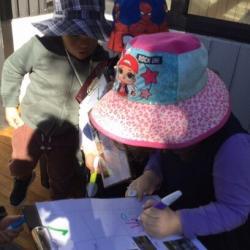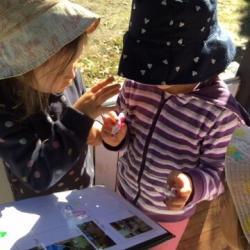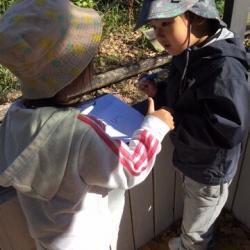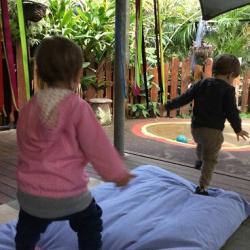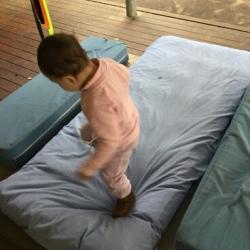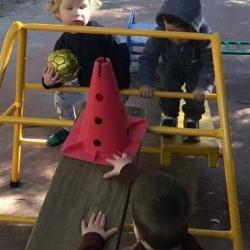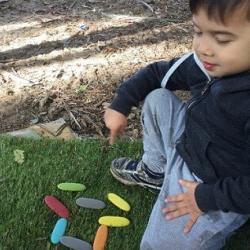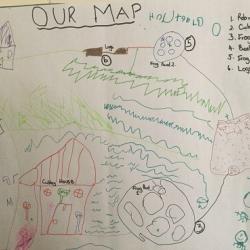Johnson House
To add to their enjoyment of exploring the grounds of The Infants Home’, this week educator Shireen invited the children in Johnson House to go on some treasure hunts. Lists of items to find were created as the children set off on their daily adventures. They were encouraged to work in collaboration with each other and to tick off each item that was found. The children began to share ideas about which direction to go in first and they negotiated who would search and who would mark items off on the board once the treasure had been found. The children attempted to read the words written on the map, with familiar letters being identified and children working out what the letters spelled. This experience highlights the variety of ways in which elements of literacy can be embedded into everyday play experiences, and the skills that children can develop when they work together, such as collaboration, negotiation and problem solving.
Murray House
Infants
Educators in Murray House infants are currently working on making changes in the learning environment to reflect children’s current interests, and to support their learning and growth.
This week educator Dalia made a water bed for the children, creating a much more fun play area. The children jumped onto it with excitement, and loved walking on the bed as they balanced their bodies. Some of the children enjoyed lying down on the wobbly bed for a moment of solitude. This bed has also been a space for the children to find comfort, soothe their emotions and regulate their feelings.
Gonzalez-Mena & Eyer (2001) suggest that materials such as pillows and mattresses can create wonderful, soft learning environments and promote children’s gross motor development.
The educators in Murray House infants are delighted to see the children giggling, laughing and having so much fun in small groups and demonstrating the ability to challenge some of their developing skills.
Toddlers
In Murray House toddlers small language groups are regularly facilitated for children throughout the day. This week educators have chosen books that have allowed them to engage in discussions with children about kindness and empathy. Their intention has been to assist children to develop an awareness of others’ perspectives and empathy. Some of the books they have shared with children include Annie’s Chair, I Need a Hug and Hugless Douglas. These books were also great vehicles for children to talk about feelings and to explore the concept of ‘acts of kindness’.
This week colourful pebbles were introduced to the children to foster their creativity and imagination. They were very popular! As an open-ended resource, they offered the children many learning possibilities. It was great for educators to see various children engaging with the pebbles differently. With educators’ help, they used them to make patterns, design houses, sort colours, classify shapes and sizes, design patterns, and to tap, stack, and count. With support the children also learned to wait, take turns, share, and develop their understanding of fairness. The children’s language skills were also fostered as they shared their play ideas with each other.
This week also saw the children displaying a strong interest in exploring how they and other things move. They demonstrated this interest by regularly requesting that educators throw balls onto the sunshade, or by pushing and throwing objects repeatedly and closely observing their movements with fascination. Responding to this newly emerging interest and play, a range of objects were provided by the educators for the children to push down an incline. Through this hands-on experience, and with adult facilitation, the children were actively exploring and building their knowledge of how things move. For instance, whether an object slides or rolls, or whether it moves fast or slow. The children have been revisiting this experience throughout each day this week, both individually, and collectively with peers.
Robinson House
The children in Robinson House have been enjoying nature walks around The Infants’ Home. During these walks they have taken the opportunity to appreciate the land they are on—Wangal Land—and to engage in experiences such as sketching and using their senses to become aware of the natural environment around them.
Educator Karen has been taking groups of children on these walks. They have been starting from Robinson House, then going to the cubby house that was built by Mate, followed by the frog ponds, the beehives near the Heritage building, and the logs on the lawn, and then finally back to Robinson House. During each stop on the nature trail the children have been sketching these spots as part of a map, leading to meaningful conversations. The children talked about bees making honey, and how bees can sting. They tried to look for frogs, but unfortunately there were none. They said “Thank you Mate!” when they bumped into him during their nature walk.
After drawing individual maps during their walk, Karen invited the children to collaborate to draw a big map. As a group they recalled the different spots on their walk, and expressed these by drawing on the big map. The children drew Robinson House, the cubby house, the ponds, the beehive and the logs, and when they were picked up by their families, they showed them where these spots were in The Infants’ Home.
This experience was a great opportunity for the children to develop their awareness, respect and appreciation for the natural environment. It also seemed to develop their sense of belonging to The Infants’ Home community as they said “hello” to children from the other Houses here along the way!
